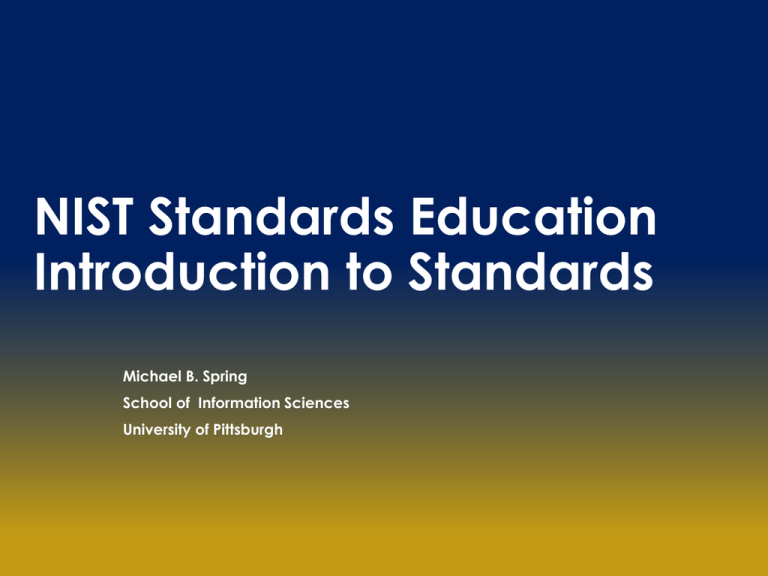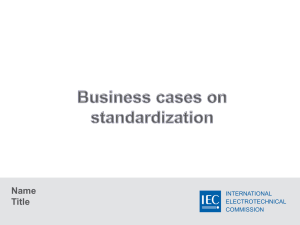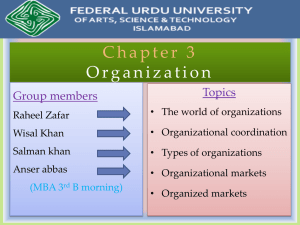Introduction to Standards - University of Pittsburgh
advertisement

NIST Standards Education Introduction to Standards Michael B. Spring School of Information Sciences University of Pittsburgh 2 Overview • What are standards • Definitions • Rise of modern standards • Fire prevention • Boilers and boiler explosions • Commerce and the Railroads • Thinking about standards • The beginnings of voluntary consensus standards • Internationally • Nationally • Looking around at standards • Areas of IT standardization Introduction to Standards 5/12/2014 3 Some History • Most of us don’t think very much about standards, and if we do it is mostly about units of measure – a foot or a meter, a quart or a liter – and indeed these are some of the earliest standards set by government decree • However, consider: • A standard for value – money – greatly facilitated the exchange of goods. The “Lydian stater” or trite may well have been the first – from about 600BC. • Also, the alphabet was an early standard for the exchange of information. • There are a number of views and definitions of standards Introduction to Standards 5/12/2014 4 Standards in Law • Magna Carta(1215) specifies: • There is to be one measure of wine and ale and corn within the realm, namely the London quarter, na done breadth of cloth, and it is to be the same with weights.(clause 35) • US Constitution, in section 8: • The Congress shall have power...to coin money, regulate the value thereof, and of foreign coin, and fix the standard of weights and measures. Introduction to Standards 5/12/2014 5 Three Definitions of Standards • The first definition is from the 1979 National Policy on Standards for the United States. • The second is based on a technical view from the American National Standard Institute (ANSI). • The third is a common view from the information technology industry. Introduction to Standards 5/12/2014 6 What Are Standards • A standard is a prescribed set of rules, conditions, or requirements concerning definition of terms; classification of components; specification of materials, performance, or operations; delineation of procedures; or measurement of quantity and quality in describing materials, products, systems, services, or practices[Committee, 1979 #5] Introduction to Standards 5/12/2014 7 What Are Standards • a technical specification or other document, available to the public, drawn up with the cooperation and consensus or general approval of all the interests affected by it, based on the consolidated results of science, technology, and experience, aimed at the promotion of optimum community benefits, and approved by a body recognized in the national, regional, or international level. (Kemmler) Introduction to Standards 5/12/2014 8 What Are Standards • A standard, of any form or type, represents a statement by its authors, who believe that their work will be understood, accepted, and implemented by the market. This belief is tempered by the understanding that the market will act in its own best interests, even if these do not coincide with the standard. A standard is also one of the agents used by the standardization process to bring about market change. (Cargill, 1989, pp 41-42) Introduction to Standards 5/12/2014 9 Key Events – 1904 Baltimore Fire • 1904 Baltimore fire caused an interest in standard fire equipment. As a result of incompatible hoses, Baltimore burned down. • Although the National Board of Fire Underwriters had been stressing the need to standardize since 1872, there were more than 600 different sizes and variations of fire hose couplings still being used in the United States. • Originally established by Congress in 1824 to establish uniform weights and measures, it was renamed the National Bureau of Standards in 1901 and charged more broadly. The Engineering Laboratory included research on building material and fire laboratory. Introduction to Standards 5/12/2014 10 Key Events – Boiler Explosions • With the industrial revolutions , there was a corresponding grown in Boiler explosions • The Grover Shoe Factory in Brocton Mass injured 150 and claimed 58 lives • The American Society of Mechanical Engineers undertook the development of standards for Pressure Vessels in the early 1900’s Introduction to Standards 5/12/2014 11 Key Event – The Rise of Railroads • Historically, time was a local matter. Each city used some form of local solar time, maintained by a well-known clock. • Standard time zones were instituted North America by the railroads on November 18, 1883 and adopted by Congress in 1918 Introduction to Standards 5/12/2014 12 Thinking about standards • Over the last 50 years, academics and the standards community have tried to come to better understand standards and the standards process • What kinds of standards are there? • How are the best standards produced? • How are standards used – what the goal • While a lot of standards research is focused on the economics of standards, there is also a growing body of research on the process of creating good standards • The various uses of standards make it increasingly important for industries and nations to understand the use of standards Introduction to Standards 5/12/2014 13 Theory of Standards • Theory should predict what will happen. • Do we have a theory of standards that explains: • • • • Why VHS beat out beta The success of the internet over OSI The rise of DOS as a standard The failure of Unix as a standard • Is there a theories about standards might be: • Standards reduces uncertainty -- thus an important aspect of economic policy • Standards are by definition public goods and therefore outside the scope of intellectual property protections Standards Organizations 5/12/2014 14 The Economists View of Standards • Economists see costs and benefits of "natural selection" in standards evolution • Benefits • the market is smart, will converge on the right choice • errors are worked out during the process • Costs • the market is slow • lots of effort wasted and not used • some people choose the wrong technology and get stranded • While the market is by definition correct, it is not always the best solution chosen by the market Standards Organizations 5/12/2014 15 The Economists View of Standards • Several economists have examined the standardization process (Farrell and Saloner, Besen, David). They address a number of different issues: • bandwagon effect -- once someone starts, everyone follows • horses, lemmings, and penguins -- different impacts of standards actions • stranding -- one of the possible problems in early adoption • lock-in -- one of the consequences of standardization • free-rideship -- the unequal burden of standardization • predatory standardization Standards Organizations 5/12/2014 16 Ways of Classing Standards • risk reduction and safety • measurement • ease of use, convenience • integration of technological improvement • Interchangeability • interoperability • Interconnectability Introduction to Standards 5/12/2014 Taxonomies 17 • David (General Taxonomy) Technical Behavioral Measurement meter, volt professional licensing Minimum Attribute steam pressure, steel strength job qualifications Compatibility USB contracts • Farrell and Saloner (types of Compatibility Standards) • physical compatibility • communications compatibility • compatibility by convention Introduction to Standards 5/12/2014 18 Other Ways of Classing Standards • By the scope of the standard • • • • Company standard Industry or enterprise standard National standard Global standard • By where the standard comes from • • • • De facto De jure Public Specification Consensus voluntary Introduction to Standards 5/12/2014 19 Where do Standards Come From? • We will be focusing on one particular kind of standard – called “voluntary consensus”, but standards have many origins. • Your computer keyboard was designed to prevent the hammers of early typewriters from jamming – it became a standard because a lot of people decided to use it – a “de facto standard” • Some standards come from government – the law. They are “de jure standards” • Some standards are accepted by the industry based on the dominance of a privately owned standard – Microsoft’s format for “Word” has been adopted my many -- a public specification • Yet other standards come from agreements reached by all the involved parties – “voluntary consensus” Introduction to Standards 5/12/2014 20 How do we use standards? • Classic standards – weights and measures – enable commerce. Indeed, weights and measures were often within the jurisdiction of the treasury function in government • Modern standards also enable commerce, but beyond that they may promote safety, interoperability, etc. • Standards can be used to create or restrict markets – indeed in recent years, corporate interests as well as engineering concerns have played a role • With the rise of free trade, standards can be used as a tool to restrict trade • Most recently, some have begun to focus on standards as enablers of innovations Introduction to Standards 5/12/2014 21 Funding Standardization • Some people are now positing that the era of standards is over and that one of two policies will come to dominate: • the provision of cheap ubiquitous computing -- read that Microsoft -- just leave it to them • the evolution of public specification by companies with dominant products -- e.g. HPGL and Postscript • As we move to international standards and a small company economy, where do you see the money or mechanisms for funding standards coming from? Standards Organizations 5/12/2014 22 International Bodies • 1865 The International Telegraph Union is created in Paris. • Leads to the International Telecommunications Union in 1934. • The ITU has among its organizational units: • The International Frequency Registration Board(IFRB) • The International Radio Consultative Committee( • 1957, the CCITT, the International Telegraph and Telephone Consultative Committee • International Telecommunications Union became a specialized agency of the UN. • 1904 The electromechnical congress, held in the US, resulted in the formation of the International Electromechanical Commission, IEC.(1906) • International Standards Organization • ISO TC 97 formed in response to ANSI X3 formation • ISO Technical Committee 97, IEC Technical Committees 47B and 83 were merged to form ISO/IEC JTC 1. Introduction to Standards 5/12/2014 23 Nationally – Government • In 1824, Congress formed the Office of Standard Weights and Measures in the Treasury Department • In 1894, consistent with what was going on internationally, it was charged with coming to grips with measurements related to electricity • 1901 responsibility was moved to commerce and the name was changed to the National Bureau of Standards • Finally, in 1988, the name was changed again to its current name –the National Institute for Standards and Technology. It’s organizational structure changes over time, with laboratories in the areas of • • • • • • Engineering Physical Measurement Information Technology Material Measurement Center for Nanoscale Science and Technology NIST Center for Neutron Research Introduction to Standards 5/12/2014 24 Nationally – Private Sector • Commerce, the growth of the railroads, both for the railroad and for the products thus distributed, the development of mass production, national distribution (Sears), and the growth of influence of the technologist, all increased the desire for standardization • In 1880, the American Society of Mechanical Engineers was formed. In the early 1900’s it played a critical role in the development of Boiler and Pressure Vessel code. • In 1898, The American Society for Testing Materials, later renamed the American Society for Testing and Materials (ASTM). ASTM is the largest non-government standards developer with more than 6500 standards. One of their initial foci was standards for steel that supported the growth of the railroads • In 1918, The American Engineering Standards Committee is founded. The AESC is the forerunner of the American National Standards Institute (ANSI), the umbrella organization for standards setting organizations. Introduction to Standards 5/12/2014 25 Areas of IT standardization • Communication Standards • Networking standards • Network infrastructure • Data Standards • Native formats • Encryption standard • Software Standards -- OS, API • Languages • OS API’s • Human-computer Interaction Standards • Icons and functionality • Transactions and Dialogs Introduction to Standards 5/12/2014 26 Standards are Critical • Think about daily life: • Imagine trying to build a house without standard lumber sizes, door sizes, window sizes, plumbing supplies, electrical wire and outlets, etc. • Imagine cars and driving without standard road signs, and traffic signals, driving rules, tire sizes, gasoline grades, etc. • Imagine computers without standards for interfaces, code sets, document formats, communications protocols would not work. • How good are you at spotting standards • Name the standards in force in this room • Name the standards that impact a computer session Introduction to Standards 5/12/2014 27 Commonly Encountered Standards • Today • Alphabet • Books • Size • Spine • ISBN • Stairs – slope and size • Roads • Signs • Grades • Bridge heights Introduction to Standards • On any given day • • • • • • • • Screw threads Motor oil Medical supplies Meat grades Weights and measures Photo sizes Film grades Image formats 5/12/2014 28 Standards in the room • • • • Plugs Window sizes Glass strength Light bulbs • • • • Door size Table height Carpet grades Paint composition • Wattage and voltage • size Introduction to Standards 5/12/2014 29 Standards in a Computer Session • Keyboard – QWERTY • Code Sets • ASCII (X3.4) • Unicode (ISO/IEC 10646) • Ports: • USB • Firewire (IEEE 1394) • Networks • Ethernet (IEEE 802.3) • Wireless (IEEE 802.11b) • Protocols • http (HyperText Transfer Protocol) Web • smtp (Simple Mail Transfer Protocol) Email Introduction to Standards 5/12/2014






